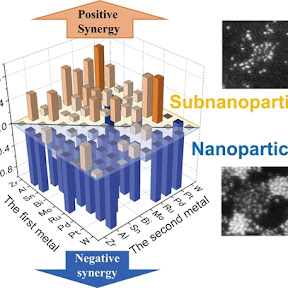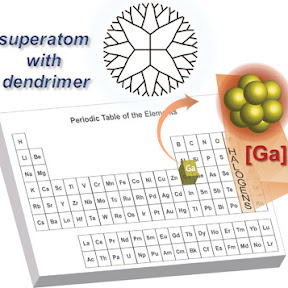トピックス
サブナノスケールでの合金化が電極触媒水素発生における相乗効果を最大化する
2022.08.01
Q. Zou, Y. Akada, A. Kuzume, M. Yoshida, T. Imaoka, K. YamamotoAngew. Chem. Int. Ed. 2022, 61, e202209675.異なる元素を結合して相乗効果を得ることは、金属触媒の性能を向上させる効果的な方法である。しかし、特性が異なるほど、相分離のために相乗効果を効果的に達成することが難しくなる。ここでは、サブナノスケールでの合金化が常に元素間の相乗効果に有効であることについての包括的な研究を説明する。36種類の二金属サブナノ粒子(SNPs)およびナノ粒子(NPs)の組み合わせを、水素発生反応(HER)に基づいて系統的に原子分解能の画像化および触媒ベンチマークを用いて研究した。結果として、SNPsは常にNPsよりも大きな相乗効果を生み出し、特にPtとZrの組み合わせが最も顕著な相乗効果を示した。サブナノスケールでの原子スケールの混和性および関連する電子状態の変調は、ナノスケールでのそれとは大きく異なり、環状暗視野走査透過電子顕微鏡(ADF-STEM)およびX線光電子分光法(XPS)によってそれぞれ観察された。Alloying at a Subnanoscale Maximizes the Synergistic Effect on the Electrocatalytic Hydrogen Evolution
Bonding dissimilar elements to provide synergistic effects is an effective way to improve the performance of metal catalysts. However, as the properties become more dissimilar, achieving synergistic effects effectively becomes more difficult due to phase separation. Here we describe a comprehensive study on how subnanoscale alloying is always effective for inter-elemental synergy. Thirty-six combinations of both bimetallic subnanoparticles (SNPs) and nanoparticles (NPs) were studied systematically using atomic-resolution imaging and catalyst benchmarking based on the hydrogen evolution reaction (HER). Results revealed that SNPs always produce greater synergistic effects than NPs, the greatest synergistic effect was found for the combination of Pt and Zr. The atomic-scale miscibility and the associated modulation of electronic states at the subnanoscale were much different from those at the nanoscale, which was observed by annular-dark-field scanning transmission electron microscopy (ADF-STEM) and X-ray photoelectron spectroscopy (XPS), respectively.
動的異金属結合を逐次原子画像化によって可視化
2022.05.27
M. Inazu, Y. Akada, T. Imaoka, Y. Hayashi, C. Takashima, H. Nakai, K. YamamotoNature Commun. 2022, 13, 2968.
従来の化学は、化学反応によって熱力学的に安定で分離可能な化合物(分子や固体)を得ることを目指して発展してきた。しかし、計算化学の最近の発展により、その場で形成される原子や分子の動的な集合と解離の研究の重要性が増している。本研究では、元素同定を伴う原子分解能で、不安定な二量体および三量体の形成および解離の動態を直接可視化する。多くの同種および異種金属二量体のビデオ記録は、Zコントラスト原理に基づく元素同定と組み合わせた走査透過型電子顕微鏡(STEM)を使用して行われる。AuAg、AgCu、およびAuAgCuなどの存在確率が低い短命な分子でさえ、低電子線量での原子の動きを識別することによって直接可視化される。
Dynamic hetero-metallic bondings visualized by sequential atom imagingTraditionally, chemistry has been developed to obtain thermodynamically stable and isolable compounds such as molecules and solids by chemical reactions. However, recent developments in computational chemistry have placed increased importance on studying the dynamic assembly and disassembly of atoms and molecules formed in situ. This study directly visualizes the formation and dissociation dynamics of labile dimers and trimers at atomic resolution with elemental identification. The video recordings of many homo- and hetero-metallic dimers are carried out by combining scanning transmission electron microscopy (STEM) with elemental identification based on the Z-contrast principle. Even short-lived molecules with low probability of existence such as AuAg, AgCu, and AuAgCu are directly visualized as a result of identifying moving atoms at low electron doses.
多核金属錯体分子の金属原子をラベルとした立体構造解析
2021.08.06
K. Takada, M. Morita, T. Imaoka, J. Kakinuma, K. Albrecht, K. YamamotoSci. Adv. 2021, 7, eabd9887.単一分子の顕微観察は化学の分野で急速に拡大しており、多数の分子を必要とする従来の特性評価技術とは異なる。このような単一分子顕微鏡の一つに高角環状暗視野走査透過電子顕微鏡(HAADF-STEM)があり、原子番号依存のコントラストのため、特に配位化合物に適している。しかし、これまでのところ、HAADF-STEMを用いた単一分子観察は単純な平面分子に限られていた。本研究では、Irを原子ラベルとして用いることで、非平面デンドロン化ポリ核Ir錯体のサブナノメートル分解能での直接構造解析を実証する。デンドリマー錯体への電子線量を減少させることが単一分子観察の鍵である。立体異性体のシミュレートされたSTEM画像との比較を行い、最も可能性の高い立体配座を決定する。我々の結果は、従来の方法では不可能であった配位高分子の構造解析を実現するための電子顕微鏡観察の可能性を拡大するものである。Metal atom–guided conformational analysis of single polynuclear coordination moleculesMicroscopic observation of single molecules is a rapidly expanding field in chemistry and differs from conventional characterization techniques that require a large number of molecules. One of such form of single-molecule microscopy is high-angle annular dark-field scanning transmission electron microscopy (HAADF-STEM), which is especially suitable for coordination compounds because of its atomic number–dependent contrast. However, to date, single-molecule observations using HAADF-STEM has limited to simple planar molecules. In the present study, we demonstrate a direct structural investigation of nonplanar dendronized polynuclear Ir complexes with subnanometer resolution using Ir as an atomic label. Decreasing the electron dose to the dendrimer complexes is critical for the single-molecule observation. A comparison with simulated STEM images of conformational isomers is performed to determine the most plausible conformation. Our results enlarge the potential of electron microscopic observation to realize structural analysis of coordination macromolecules, which has been impossible with conventional methods.
中心の銀が白金サブナノクラスターの室温燐光を18倍に向上
2020.11.07
Y. Akanuma, T. Imaoka, H. Sato, K. YamamotoAngew. Chem. Int. Ed. 2021, 60, 4551-4554.リガンドで保護された金属ナノクラスターの発光における金属コア(金属-金属相互作用)とシェル(金属-リガンド相互作用)の役割については議論が続いている。我々は、白金-チオレート錯体およびその銀イオン包含錯体(銀ドープ白金サブナノクラスター)の凝集誘起室温燐光を発見した。銀イオンの包含により、発光量子収率が18倍に向上した。光物理的測定では、銀ドープ白金サブナノクラスターの非放射減衰速度が遅くなることが示された。DFT計算により、主にAgのs軌道とPtのd軌道からなるLUMOが、励起状態での構造歪みを抑制する重要な役割を果たしていることが明らかになった。この研究は、原子レベルで精密に制御された多金属発光ナノクラスターの分子軌道に基づいた設計戦略の研究を刺激することを期待している。Silver in the Center Enhances Room-Temperature Phosphorescence of a Platinum Sub-nanocluster by 18 Times
There has been controversy surrounding the roles of the metal core (metal–metal interaction) and the shell (metal–ligand interaction) in photoluminescence of ligand-protected metal nanoclusters. We have discovered aggregation-induced room-temperature phosphorescence of a platinum–thiolate complex and its silver ion inclusion complex (a silver-doped platinum sub-nanocluster). The inclusion of silver ion boosted the photoluminescent quantum yield by 18 times. Photophysical measurements indicate that the rate of nonradiative decay was slower for the silver-doped platinum sub-nanocluster. DFT calculations showed that the LUMO, which had the main contribution from Ag s-orbital and Pt d-orbitals, played a critical role in suppressing the structural distortion at the excited state. This work will hopefully stimulate more research on designing strategies based on molecular orbitals of atomicity-precise luminescent multimetallic nanoclusters.
貴金属多金属1ナノメートル触媒によるオレフィンの選択的ヒドロペルオキシド化の実現
2020.08.26
T. Moriai, T. Tsukamoto, M. Tanabe, T. Kambe, K. YamamotoAngew. Chem. Int. Ed. 2020, 59, 23051-23055.
サブナノメートル(約1 nm)スケールの粒子科学は、世界中の注目を集めている。しかし、サブナノ粒子(SNPs)の精密な合成の技術的難しさのため、未踏の領域であった。最近、適切に設計されたマクロ分子をテンプレートとして使用することにより、SNPsを精密に合成する「原子ハイブリッド化法(AHM)」を開発した。現在、AHMによって得られた合金SNPsの化学反応性を調査した。貴金属元素に注目し、これらのSNPsが触媒するオレフィンの酸化反応を系統的に評価した。SNPsは、従来の触媒よりも穏やかな条件下でも高い触媒性能を示した。さらに、複数の元素のハイブリッド化により、ヒドロペルオキシド誘導体の形成に対するターンオーバー周波数と選択性が向上した。材料の小型化とハイブリッド化の観点から、一般に不安定なヒドロペルオキシドを提供するユニークな量子サイズ触媒について議論する。
Selective Hydroperoxygenation of Olefins Realized by a Coinage Multimetallic 1-Nanometer CatalystThe science of particles on a sub-nanometer (ca. 1 nm) scale has attracted worldwide attention. However, it has remained unexplored because of the technical difficulty in the precise synthesis of sub-nanoparticles (SNPs). We recently developed the “atom-hybridization method (AHM)” for the precise synthesis of SNPs by using a suitably designed macromolecule as a template. We have now investigated the chemical reactivity of alloy SNPs obtained by the AHM. Focusing on the coinage metal elements, we systematically evaluated the oxidation reaction of an olefin catalyzed by these SNPs. The SNPs showed high catalytic performance even under milder conditions than those used with conventional catalysts. Additionally, the hybridization of multiple elements enhanced the turnover frequency and the selectivity for the formation of the hydroperoxide derivative. We discuss the unique quantum-sized catalysts providing generally unstable hydroperoxides from the viewpoint of the miniaturization and hybridization of materials.
デンドリマー内の超原子ガリウムクラスター:原子数に依存する独自の剛性と反応性
2020.02.21
T. Kambe, A. Watanabe, M. Li, T. Tsukamoto, T. Imaoka, K. YamamotoAdv. Mater. 2020, 32, 1907167.
超原子は他の元素の代替としての可能性があるため、研究されてきた。超原子の溶液相合成は、その利用可能性を実現するために注目を集めている。しかし、従来のアプローチは基本的に単一クラスターの形成に限られていた。ここでは、超原子を調査し、これらの超原子内の原子価電子の数を、存在するガリウム原子の数を設計することで変化させた。デンドリマーテンプレート法に基づいて、3、12、13、およびその他の数の原子からなるクラスターが合成された。Ga13のハロゲンのような超原子特性は、他のクラスターとは全く異なる構造的および電気化学的な観察によって明らかにされた。2Pおよび1P超原子軌道をそれぞれ満たすことができる13および3原子のガリウムクラスターは、異なる反応性を示す。3原子のガリウムクラスターは、未占有軌道のエネルギーレベルの低下によりGa3H2−に還元されることが示唆されている。これらのガリウムクラスターの結果は、超原子の候補を提供する。
Superatomic Gallium Clusters in Dendrimers: Unique Rigidity and Reactivity Depending on their AtomicitySuperatoms have been investigated due to their possible substitution for other elements. The solution-phase synthesis of superatoms has attracted attention to realize the availability of superatoms. However, the previous approach is basically limited to the formation of a single cluster. Here, superatoms are investigated and the number of valence electrons in these superatoms is changed by designing the number of gallium atoms present. Based on the dendrimer template method, clusters consisting of 3, 12, 13, and other numbers of atoms have been synthesized. The halogen-like superatomic nature of Ga13 is structurally and electrochemically observed as completely different to the other clusters. The gallium clusters of 13 and 3 atoms, which can fill the 2P and 1P superatomic orbitals, respectively, exhibit different reactivities. The 3-atom gallium cluster is suggested as being reduced to Ga3H2− due to the lower shift of energy levels in the unoccupied orbitals. The results for these gallium clusters provide candidates for superatoms.
サブナノサイエンスのための超高感度ラマン分光法:スズ酸化物クラスターの直接観察
2019.12.13
A. Kuzume, M. Ozawa, Y. Tang, Y. Yamada, N. Haruta, K. Yamamoto
Sci. Adv. 2019, 5, eaax6455.
サブナノメートルの金属クラスターは、次世代材料として革新的な応用を示唆する異常な触媒活性を示すが、従来の分析方法では信号強度が極めて弱いため、これらのサブナノ材料を原子レベルで特定および特徴付けることは大きな課題である。ここでは、表面増強ラマン分光法に基づいて確立されたサブナノ感度の振動技術を報告し、サブナノ材料の詳細な振動特性評価を初めて実現した。さらに、密度汎関数理論計算と組み合わせることで、スズ酸化物サブナノクラスターの固有の表面構造が、これらのクラスターのサイズ特有のスペクトルおよび触媒特性を決定することを明らかにする。ここで詳述された高感度の特性評価方法は、触媒、バイオセンサー、電子機器などの実用的な応用のために、サブナノ材料の化学的および構造的性質を包括的に理解し、原子スケールでの合理的な設計を促進することができる。
Ultrahigh sensitive Raman spectroscopy for subnanoscience: Direct observation of tin oxide clustersSubnanometric metal clusters exhibit anomalous catalytic activity, suggesting innovative applications as next-generation materials, although identifying and characterizing these subnanomaterials in atomic detail remains a substantial challenge because of the severely weak signal intensity for the conventional analytical methods. Here, we report a subnanosensitive vibrational technique established based on the surface-enhanced Raman spectroscopy, demonstrating the first-ever detailed vibrational characterization of subnanomaterials. Furthermore, combining with density functional theory calculations, we reveal that inherent surface structures of the tin oxide subnanoclusters determine the size-specific spectral and catalytic characteristics of these clusters. The high-sensitivity characterization methodology elaborated here can provide a comprehensive understanding of the chemical and structural natures of subnanomaterials, which facilitate the rational design of subnanomaterials on the atomic scale for practical applications, such as in catalysts, biosensors, and electronics.
多金属クラスター合成のための原子ハイブリッド化
2018.10.30
T. Tsukamoto, T. Kambe, A. Nakao, T. Imaoka, K. Yamamoto
Nature Commun. 2018, 9, 3873.
多元合金ナノ粒子の新たな合成手法を開発
サブナノメートルスケールの金属クラスターの化学は、特に多金属クラスターにおいて、サイズと組成を制御して合成することが難しいため、まだ十分に理解されていない。多金属サブナノクラスターのテンプレート合成は、マクロ分子テンプレートとしてフェニルアゾメチンデンドリマーを使用することによって達成される。その分子内ポテンシャル勾配により、最大8元素を含む金属前駆体複合体をテンプレート上に正確に取り込むことが可能である。この方法の有用性は、5元素(Ga1In1Au3Bi2Sn6)から成る多金属サブナノクラスターを合成することで実証されている。このクラスターのサイズと組成は正確に制御され、関与する金属は互いに合金化される。このアプローチは、異なる金属をさまざまな組み合わせで簡単にブレンドし、サブナノメートルスケールの新しい材料を作成する能力を提供し、化学の分野における新しい領域の発展につながるであろう。
Atom-hybridization for Synthesis of Polymetallic ClustersThe chemistry of metal clusters on the sub-nanometer scale is not yet well understood because metal clusters, especially multimetallic clusters, are difficult to synthesize with control over size and composition. The template synthesis of multimetallic sub-nanoclusters is achieved using a phenylazomethine dendrimer as a macromolecular template. Its intramolecular potential gradient allows the precise uptake of metal precursor complexes containing up to eight elements on the template. The usefulness of this method is demonstrated by synthesizing multimetallic sub-nanoclusters composed of five elements (Ga1In1Au3Bi2Sn6). The size and composition of this cluster can be precisely controlled and the metals involved are alloyed with each other. This approach provides the ability to easily blend different metals in various combinations to create new materials on the sub-nanometer scale, which will lead to the development of a new area in the field of chemistry.
原子数明確な白金クラスター担持触媒の大量合成
2017.09.25
T. Imaoka, Y. Akanuma, N. Haruta, S. Tsuchiya, K. Ishihara, T. Okayasu, W.-J. Chun, M. Takahashi, K. Yamamoto
Nature Commun. 2017, 8, 688.
サブナノメートルの貴金属クラスターは、特に触媒用途において非常に大きな可能性を秘めている。わずか1つの原子の違いがその反応性に大きな変化を引き起こすため、原子レベルの精度での調製方法が不可欠である。このような精度がガス相合成によって達成されているが、大規模な調製は依然として最前線にあり、実用的な応用を妨げている。我々は、ティアラ状の白金複合体(リング数 n=5–13)からミリグラムスケールでの白金クラスターの原子精度かつ完全にスケーラブルな合成を示す。水素流中での炭素支持体上の複合体の低温焼成により、前駆体複合体と同じ原子性を持つ単分散の白金クラスターが得られる。これらのクラスターのうち、Pt10クラスターは他のクラスターに比べてスチレンの水素化において高い触媒活性を示す。この方法は、これらのクラスターを調製スケールの触媒作用に応用するための道を開く。
Platinum clusters with precise numbers of atoms for preparative-scale catalysis
Subnanometer noble metal clusters have enormous potential, mainly for catalytic applications. Because a difference of only one atom may cause significant changes in their reactivity, a preparation method with atomic-level precision is essential. Although such a precision with enough scalability has been achieved by gas-phase synthesis, large-scale preparation is still at the frontier, hampering practical applications. We now show the atom-precise and fully scalable synthesis of platinum clusters on a milligram scale from tiara-like platinum complexes with various ring numbers (n = 5–13). Low-temperature calcination of the complexes on a carbon support under hydrogen stream affords monodispersed platinum clusters, whose atomicity is equivalent to that of the precursor complex. One of the clusters (Pt10) exhibits high catalytic activity in the hydrogenation of styrene compared to that of the other clusters. This method opens an avenue for the application of these clusters to preparative-scale catalysis.
溶媒を使用しない炭化水素の好気的酸化のための精密に制御された多金属ナノクラスター触媒
2017.07.26
M. Takahashi, H. Koizumi, W. Chun, M. Kori, T. Imaoka, K. Yamamoto
Sci. Adv. 2017, 3, e1700101.
合金ナノ粒子の触媒活性は、粒子サイズと異なる金属の組成比に依存する。Pd、Pt、およびAuからなる合金ナノ粒子は、酸化反応の触媒として広く使用されている。酸化反応におけるPtおよびAuナノ粒子の触媒活性は、粒子サイズが小さくなるほど増加し、合金ナノ粒子の金属間界面で増加することが知られている。したがって、直径約1 nmの多金属ナノクラスター(MNCs)は酸化反応の触媒としての可能性を持つ。しかし、均一な合金ナノクラスターの調製に関する報告はほとんどない。我々は、塩基性の勾配を持つ配位サイトを備えた高分子テンプレートを使用して、精密に制御されたMNCs(約1 nm)を合成する方法を報告する。グラファイト化されたメソポーラス炭素に支持されたCu-Pt-Au MNCsは、炭化水素の好気的酸化において市販のPt触媒の24倍の触媒活性を示すことを明らかにした。さらに、炭化水素をケトンに変換する溶媒を使用しない好気的酸化反応を、少量のラジカル開始剤を用いて常温で行うことに成功し、これは初めての固体触媒による反応である。
Finely controlled multimetallic nanocluster catalysts for solvent-free aerobic oxidation of hydrocarbons
The catalytic activity of alloy nanoparticles depends on the particle size and composition ratio of different metals. Alloy nanoparticles composed of Pd, Pt, and Au are widely used as catalysts for oxidation reactions. The catalytic activities of Pt and Au nanoparticles in oxidation reactions are known to increase as the particle size decreases and to increase on the metal-metal interface of alloy nanoparticles. Therefore, multimetallic nanoclusters (MNCs) around 1 nm in diameter have potential as catalysts for oxidation reactions. However, there have been few reports describing the preparation of uniform alloy nanoclusters. We report the synthesis of finely controlled MNCs (around 1 nm) using a macromolecular template with coordination sites arranged in a gradient of basicity. We reveal that Cu-Pt-Au MNCs supported on graphitized mesoporous carbon show catalytic activity that is 24 times greater than that of a commercially available Pt catalyst for aerobic oxidation of hydrocarbons. In addition, solvent-free aerobic oxidation of hydrocarbons to ketones at room temperature, using small amounts of a radical initiator, was achieved as a heterogeneous catalytic reaction for the first time.









